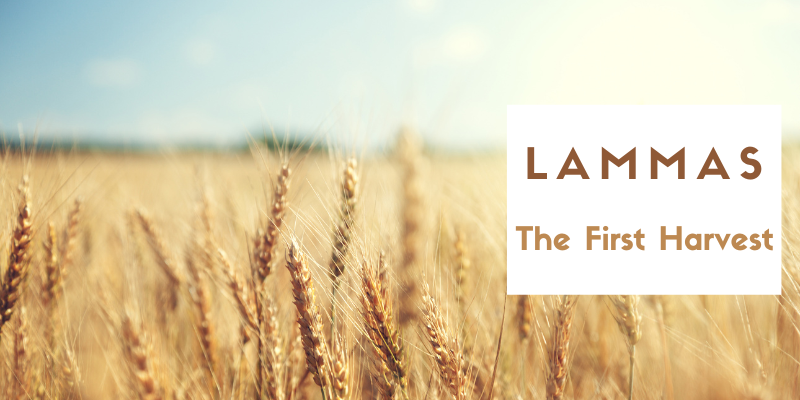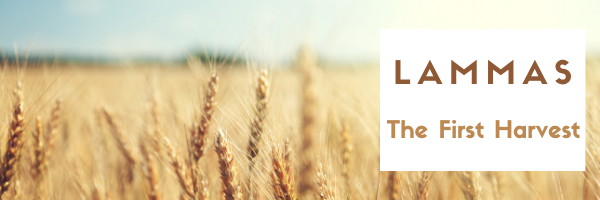|
Lammas is a festival marking the grain harvest and is the midway point between the summer solstice and the fall equinox. The standard invitation is to reflect on what was planted in the spring to see what you are harvesting now. And if this is your headspace this year I invite you to check out last year’s post.
My headspace is swirling with thoughts and questions of rest and paring down. “What do you need to let rest?” “What needs to be released?” are a couple questions that come to mind. While these questions on the surface don’t seem to align with the harvest season we are in, the questions are central to land-tending and soul-tending in modern times. The questions at heart are about discernment - making decisions to create environments where the land and humans can thrive. Contrary to what society wants us to believe (indoctrinated us to believe), we cannot keep producing without rest. A continuous churning of productivity will eventually lead to nutrients lost and burnout both of land and people. We want so much to thrive and often the messaging is to hustle to achieve thriving. But rest is a vital part of the production process and we must tend these boundaries for ourselves in a culture that encroaches on our body-landscapes continuously. In the Jewish tradition we have what is called Shmita. Every seven years we were commanded to let the fields rest, and in turn, we were released from some of the demands of our daily lives. This seventh year, a Sabbath year, is called Shmita - Hebrew for “release”. In the modern era the Shmita year has become a guiding principle not just for physical land, but also for our inner landscapes. Shmita can take the form of letting our home gardens rest, taking sabbaticals from busy schedules, or simply using discerning questions to help us prune our lives from what no longer feeds us. How does one let the land rest and still survive? It certainly takes some planning, embracing interconnectedness, and a redistribution of focus. AND when Shmita is followed the land doesn’t rest as much as it’s given the chance to do its own thing. Land still produces without human intervention - it simply and naturally finds it own rhythm and possibilities for growth. It is a year of releasing the land from expectations and bending to human desires. What would your year be like if you gave yourself the same release? During the traditional time of harvesting what happens in a year when there is nothing to immediately gather? How does taking time to rest and renew feed our relationship to time? Many lives have returned to the busy-ness of pre-pandemic (though the pandemic isn’t over) and to consider taking a rest so soon after many experienced the pandemic as a forced time out seems a hard NO. As humans we love all or nothing…but there is so much in between. We can rest our bodies, minds, and our land in micro and macro ways. We can rest to discern what has meaning and what needs to be released without putting ourselves in a time out that goes against our nature. You do you. AND…how do you know you? The you that isn’t cultivated and curated? The you that isn’t trimmed and organized? The you who is like the land left to be feral and free? I would argue one of the ways to answer these soul-touching questions is to give yourself some spaciousness and time…to be like the land in the Shmita year, and see how you grow when returned to your natural way. Blessings, Valerie
0 Comments
In following the natural cycle of the year, there are eight major turning points. Two solstices, two equinoxes, and the four midpoints between the solstices & equinoxes (Imbolc, Beltane, Lammas, and Samhain). On this wheel of the year, we find ourselves at the celebration of the first harvest - Lammas.
It’s natural to look back and ask, “what did I plant in the spring that I am harvesting now?” Certainly that is one way to look at this time. Another possibility is to take a longer view of what it means to plant and harvest in a human life. One lesson I learned on my spiritual journey is that everything takes time and more time than we think it should. I am not a patient person (I don’t know many people who are), but in the natural world and the spirit world most things that lead to a valuable harvest take time, way more time than we think/want it to. In our physical gardens, I don’t know anyone that pulls the plant up by the roots to see how it’s growing. That would lead to certain death for the plant. But this is a common energy in our spirit-led lives. “Are we there yet” and its many iterations is the most human question we can ask. The energy of the question is the same as pulling a plant up by its roots. An act that damages our spiritual harvest before it can even sprout tender leaves. Leading a spirit-led life requires us to acknowledge there is no “there” to arrive to and the timing is often mysterious and unknown. Each arrival gives a new horizon to move towards and more depth to sink into. In seeing where we planted seeds and what we are harvesting now, what would it be like to look back 3 years, 9 years, 18 years, and 27 years for the vision of what is coming to harvest now? For me, 18 years ago I was three years into a 20+ year journey with my energy healing teacher Rosalyn. Twenty seven years ago, in 1994, I met my first formal spiritual teacher Julia and stepped onto a dedicated path of devoting my life to the Spiritual. Three years ago, I was in one of the most challenging spaces of my life - relearning basic skills that I needed to live a daily life in the modern world. Each one of these seeds bears fruit today. This doesn’t mean that life is all rainbows and unicorns, but through the toil of the present, a harvest emerges. What would it feel like to hold life as a revolving garden - one where planting, harvesting, and wintering occur simultaneously within the movement of our lives? In this moment, each one of us experiences planting, harvesting, and resting (most likely not in equal measure) and because we are beings that are multidimensional and beautifully complex, we can embody all of this, even if it’s just a molecule of one and an abundance of another. Planting, harvesting, and wintering are the natural energies of our world, and we are not separate but interconnected to the land and people around us. Anchoring into the natural world opens us up to honor what IS while understanding that time moves forward. If you find yourself disoriented and looking for clarity, the natural rhythms are always your friend. Your honoring and connection doesn't need to be a grand gesture. It can be simple, quiet, subtle, and nuanced and will be just as sacred and meaningful. A small gesture is powerful to the sacred world. I invite you to think of some small act to honor your rhythm of planting, harvesting, and wintering that is happening in this moment of the sacred wheel of the natural world. During this season of harvest, I am grateful for you. For all the ways we connected and for the opportunity to share my gifts & resources with you. I'm humbled that this is the work that chose me and found each of you.
In following the natural cycle of the year, there are eight major turning points. Two solstices, two equinoxes, and the four midpoints between the solstices & equinoxes (Imbolc, Beltane, Lammas, and Samhain). On this wheel of the year, we find ourselves at the celebration of the first harvest - Lammas. Here is a moment to reflect on what you planted at the beginning of Spring and observe what you are harvesting now. As any gardener knows, one does not have full control over the outcome of the crops. Gardens are at the mercy of the quality of seed, the quantity of water, the mercurialness of temperature, the hunger of animals, and the skill of the gardener. With the best of intentions, some years the garden just doesn't grow as planned. Many of us are harvesting radically different crops than what we envisioned for ourselves at the end of winter and the beginning of spring.
COVID arrived in most of our lives right at the beginning of our planting season. Winter's planning and dreaming mostly likely isn't what we planted or are harvesting now. It feels important to acknowledge this and reflect on what is here in this moment. For some, there has been new growth in places once not thought possible, for others - heartache and grief at the loss of loved ones, opportunities, and a culture that feels in chaos. I invite you to be with all of it - not because it's easy and comfortable - but because it is necessary for healing and carry all of this forward. This will not be the only invitation for harvest and reflection from the natural world this year - we still have two more Fall harvest holidays. In addition, this could be a time to plant some new seeds for fall crops. Now is the time to plan & plant with careful consideration of the current climate and then follow with right action. Anchoring into the natural world opens us up to honor what is while understanding that time moves forward. Tentative step by tentative step we carry within us the deep knowing of what has been lost (as well as gained) and also the tender faith of a new day. If you find yourself disoriented and looking for clarity the natural rhythms are always your friend. Your honoring and connection doesn't need to be a grand gesture. It can be simple, quiet, and modest and will be just as sacred and meaningful. In this moment of harvest, I am grateful for you. For all the ways we connected and for the opportunity to share my gifts & resources with you. I'm humbled that this is the work that chose me and found each of you. Sincerely, Valerie |
�
Blog Archives
May 2023
Categories
All
|




 RSS Feed
RSS Feed